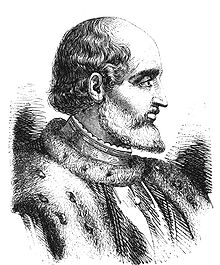Matteo I. Visconti
Matteo I. Visconti (born August 15, 1250 in Invorio ; † June 24, 1322 in Crescenzago) from the Visconti family succeeded his uncle, Archbishop Ottone Visconti , as the political leader of Milan in 1295. As early as 1294 he had been appointed imperial vicar by Adolf von Nassau . Although a riot of della Torre 1302 him to flee to Verona forced him brought his steadfast loyalty to the imperial cause in Italy the gratitude of Henry VII. (Reigned 1308-1313), the reinstatement in Milan in 1311 and the Office of the Imperial Vicar of Lombardy one . He brought Piacenza , Tortona , Pavia , Bergamo , Vercelli , Cremona and Alessandria under his rule. Though a capable general, he relied more heavily on diplomacy and bribery for his acquisitions, and was viewed as the model of a cautious Italian despot. His persistent Ghibelline policy and his dispute with Pope John XXII. (ruled 1316–1334) over the occupation of the bishopric in Milan brought him in 1322 excommunication by the papal legate Bertrand du Pouget . He abdicated in 1322 in favor of his son Galeazzo I. Visconti and died shortly afterwards.
Matteo Visconti was married to Bonacossa († January 13, 1321 ), the daughter of Condottiere Squarcino Borri , since 1269 . The couple had the following children:
- Galeazzo I. Visconti (1277-1328)
- Luchino Visconti (1287-1349)
- Stefano Visconti († July 4, 1327 )
- Marco Visconti († murdered 1329 ), Podestà from Alessandria
- Giovanni Visconti (1290-1354)
- Caterina Visconti ∞ 1298 Alboino I della Scala († 1311)
- Zaccarino Visconti ∞ Franchino Rusca
- Agnes Visconti ∞ Cecchino della Scala († 1325)
literature
- The New Encyclopaedia Britannica, Vol. 12 (1993), p. 395.
- Francesca Maria Vaglienti: Visconti, Matteo I. In: Lexikon des Mittelalters , Volume 8 (1997), Col. 1725 f.
- Francesco Cognasso : I Visconti. Dall'Oglio, Milan 1987, ISBN 88-7718-346-2 . (Reprint of the Milan 1972 edition).
Web links
- Visconti, Matteo I . In: Treccani Enciclopedia online.
- Publications on Matteo Visconti in the Opac der Regesta Imperii
Remarks
- ^ District of Milan, Zone 2
| predecessor | Office | successor |
|---|---|---|
| Ottone Visconti |
Mayor of Milan (1287–1302) (1310–1322) |
Galeazzo I. Visconti |
| personal data | |
|---|---|
| SURNAME | Matteo I. Visconti |
| BRIEF DESCRIPTION | political leader of Milan |
| DATE OF BIRTH | August 15, 1250 |
| PLACE OF BIRTH | Invorio |
| DATE OF DEATH | June 24, 1322 |
| Place of death | Crescenzago |
